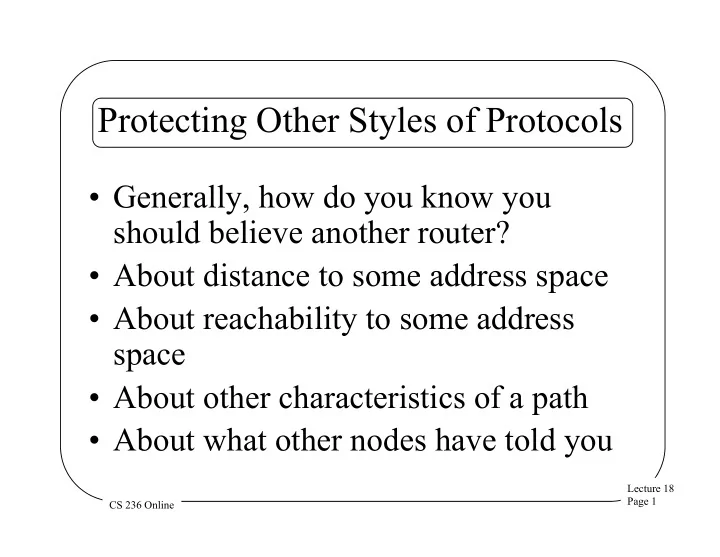

Protecting Other Styles of Protocols • Generally, how do you know you should believe another router? • About distance to some address space • About reachability to some address space • About other characteristics of a path • About what other nodes have told you Lecture 18 Page 1 CS 236 Online
How Routing Protocols Pass Information • Some protocols pass full information – E.g., BGP – So they can pass signed information • Others pass summary information – E.g., RIP – They use other updates to create new summaries – How can we be sure they did so properly? Lecture 18 Page 2 CS 236 Online
Who Are You Worried About? • Random attackers? – Generally solvable by encrypting/ authenticating routing updates • Misbehaving insiders? – A much harder problem – They’re supposed to make decisions – How do you know they’re lying? Lecture 18 Page 3 CS 236 Online
A Sample Problem 1 2 3 1 B C D E 0 A H 1.2.3.* 0 F G How can H tell 1 2 someone lied? Assume a distance How can H tell vector protocol that E lied? Lecture 18 Page 4 CS 236 Online
Types of Attacks on Distance Vector Routing Protocols • Blackhole attacks – Claim short route to target • Claim longer distance – To avoid traffic going through you • Inject routing loops – Which cause traffic to be dropped • Inject lots of routing updates – Generally for denial of service Lecture 18 Page 5 CS 236 Online
How To Secure a Distance Vector Protocol? • Can’t just sign the hop count – Not tied to the path • Instead, sign a length and a “second-to- last” router identity • By iterating, you can verify path length Lecture 18 Page 6 CS 236 Online
An Example B C D E A H 1.2.3.* F G H needs to build Should show hop a routing table count of 3 via G, entry for 1.2.3.* 5 via E Lecture 18 Page 7 CS 236 Online
One Way to Do It E 1 - B C D E D 2 E A H C 3 D F G B 4 C A 5 B H directly verifies Now we can trust it’s that it’s one hop to E five hops to A H gets signed info that D is 2 hops through E Then we iterate Lecture 18 Page 8 CS 236 Online
Who Does the Signing? • The destination – A in the example • It only signs the unchanging part – Not the hop count • But an update eventually reaches H that was signed by A Lecture 18 Page 9 CS 236 Online
What About That Hop Count? • E could lie about the hop count • But he can’t lie that A is next to B • Nor that B next to C, nor C next to D, nor D next to E • Unless other nodes collude, E can’t claim to be closer to A than he is Lecture 18 Page 10 CS 236 Online
What If Someone Lies? E 1 - B C D E D 2 E A H C 3 D F G B 4 C A 5 B There’s limited scope for effective lies E can’t claim to be Since E can’t produce a closer to A routing update signed by A that substantiates that Lecture 18 Page 11 CS 236 Online
A Difficulty • This approach relies on a PKI • H must be able to check the various signatures • Breaks down if someone doesn’t sign – That’s a hole in the network, from the verification point of view – Consider, in example, what happens if C doesn’t sign Lecture 18 Page 12 CS 236 Online
What If C Doesn’t Sign? E 1 - B C D E D 2 E A H C 3 D F G B 4 C A message coming A 5 B through D tells us that But how can he be sure D it’s three hops to C is next to C? But H can’t verify that Other than trusting D . . . H knows C is next to B And that B is next to A Lecture 18 Page 13 CS 236 Online
What’s the Problem? E 1 - B C D E D 2 E A H C 3 D F G B 4 C A 5 B For this graph, no problem But how about for this one? B C D E A H F G Lecture 18 Page 14 CS 236 Online
Recommend
More recommend